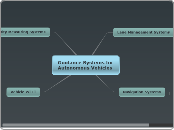Guidance Systems for Autonomous Vehicles
Lane Management Systems
Pavement Magnet Sensors
Steering systems guided by the use of embedded pavement magnets hold promise in future but later developments of autonomous vehicles because they not only provide a precise path for a vehicle's sensors, but also tend to be unaffected by weather conditions that may otherwise obscure optical sensors.
Optical Sensors
Optical sensors can also be resourceful for autonomous vehicles when concerning lane guidance systems. This is true because through the use of pavement marking readers, a vehicle can properly position itself in the center of the lane without much difficulty. However, they would only be permitted when road conditions are favorable.
Navigation Systems
Integrated GPS
Future autonomous vehicles will most likely come with a fully integrated GPS. This feature is highly useful because it can provide the driver with location details and send important positioning information to the computer responsible for the autonomous driving.
Proximity Measuring Systems
LIDAR
Vehicles equipped with LIDAR systems can emit beams of infrared light from all sides and calculate the time it takes for all beams to be reflected back. Based on the times received, the vehicle can calculate the distance between itself and other objects. This procedure is commonly used by law enforcement personnel for speed enforcement.
Radar
In a fashion similar to LIDAR, the distance between vehicles and objects on the road can be calculated by the time it takes for radio waves emitted by the vehicle to be reflected back. However, radar will only be useful for short distance calculations since the waves tend to diverge widely.
Vehicle Wi-Fi
Traffic Network
Autonomous vehicles may also be connected to a traffic operations network. For example, the vehicle will be connected to a network that allows it to automatically receive updates such as road construction projects, traffic delays, traffic signal phases, and highway closures.
